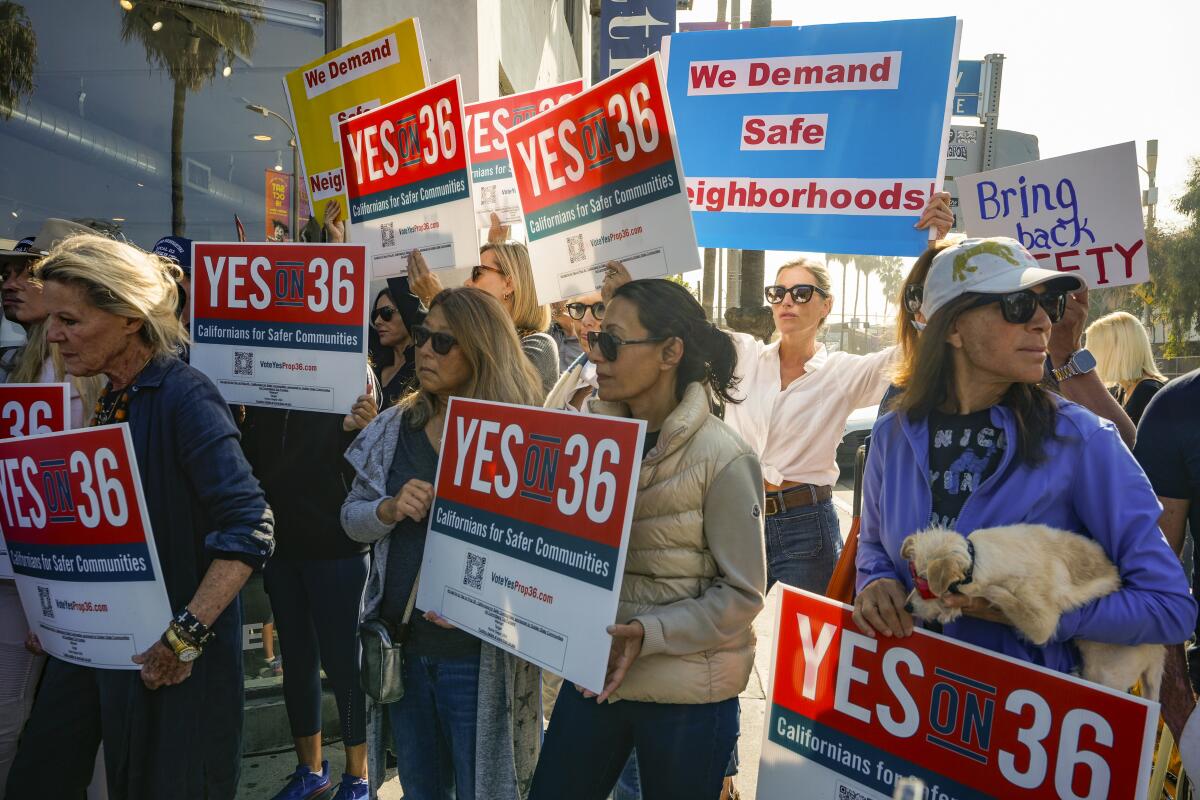Newsom insults California voters by not funding Proposition 36

- Share via
SACRAMENTO — This just seems wrong: Californians overwhelmingly approved an anti-crime ballot measure in November. But our governor strongly opposed the proposition. So he’s not funding it.
Gov. Gavin Newsom and Democratic legislative leaders, however, are now under pressure to fund the measure in a new state budget that’s being negotiated and must pass the Legislature by June 15.
A core principle of democracy is the rule of law. A governor may dislike a law, but normally is duty- bound to help implement and enforce it. Heaven save us if governors start traipsing the twisted path of President Trump.
You're reading the L.A. Times Politics newsletter
George Skelton and Michael Wilner cover the insights, legislation, players and politics you need to know in 2024. In your inbox Monday and Thursday mornings.
You may occasionally receive promotional content from the Los Angeles Times.
But this isn’t the first time for Newsom. Voters twice — in 2012 and 2016 — rejected ballot measures to eliminate the death penalty. Moreover, in 2016 they voted to expedite executions. But shortly after becoming governor in 2019, Newsom ignored the voters and declared a moratorium on capital punishment.
Nothing on California’s ballot last year got more votes than Proposition 36, which increases punishment for repeated theft and hard drug offenses and requires treatment for repetitive criminal addicts.
It passed with 68.4% of the vote, carrying all 58 counties — 55 of them by landslide margins, including all counties in the liberal San Francisco Bay Area.
“To call it a mandate is an understatement,” says Greg Totten, chief executive officer of the California District Attorneys Assn., which sponsored the initiative. Big retailers bankrolled it.
“It isn’t a red or blue issue,” adds Totten, referring to providing enough money to fund the promised drug and mental health treatment. “It’s what’s compassionate and what’s right and what the public expects us to do.”
Rolled back Proposition 47
Proposition 36 partly rolled back the sentence-softening Proposition 47 that voters passed 10 years earlier and was loudly promoted by then-Lt. Gov. Newsom.
Proposition 47 reduced certain property and hard drug crimes from felonies to misdemeanors and arrests plummeted, the nonpartisan Public Policy Institute of California found.
Proposition 36 was inspired by escalating retail theft, including smash-and-grab burglaries, that were virtually unpunished. Increased peddling of deadly fentanyl also stirred the public.
The ballot measure imposed tougher penalties for dealing and possessing fentanyl, treating it like other hard drugs, such as heroin and cocaine. But the proposition offered a carrot to addicted serial criminals: Many could be offered treatment rather than jail time.
Newsom adamantly opposed Proposition 36.
“We don’t need to go back to the broken policies of the last century,” the governor declared. “Mass incarceration has been proven ineffective and is not the answer.”
Newsom tried to sabotage Proposition 36 by crafting an alternative ballot measure. Top legislative leaders went along. But rank-and-file Democratic lawmakers rebelled and Newsom abandoned the effort.
The Legislature ultimately passed 13 anti-theft bills that Newsom and Democrats hoped would satisfy voters, but didn’t come close. Totten called the legislative product “half measures.”
Proposition 36 was flawed in one regard: It lacked a funding mechanism. That was part of the backers’ political strategy. To specify a revenue source — a tax increase, the raid of an existing program — would have created a fat target for opponents.
Let the governor and the Legislature decide how to fund it, sponsors decided.
“We didn’t want to tie the hands of the Legislature,” Totten says. “The Legislature doesn’t like that.”
Anti-crime measure won’t work without funding
Without funding from Sacramento, Proposition 36 won’t work, says Graham Knaus, chief executive officer of the California State Assn. of Counties.
“We believe strongly that if it’s not properly funded, it’s going to fail,” Knaus says. “Proposition 36 requires increased capacity for mental health and substance abuse treatment. And until that’s in place, there’s not really a way to make the sentencing work.”
There’s a fear among Proposition 36 supporters that if treatment isn’t offered to qualifying addicts, courts won’t allow jail sentencing.
“That will probably get litigated,” Totten says.
“Counties can’t implement 36 for free,” Knaus says. “Voters declared this to be a top-level priority. It’s on the state to determine how to fund it. Counties have a very limited ability to raise revenue.”
The district attorney and county organizations peg the annual cost of implementing the measure at $250 million. State Senate Republicans are shooting for the moon: $400 million. The nonpartisan legislative analyst originally figured that the cost ranged “from several tens of millions of dollars to the low hundreds of millions of dollars each year.”
Newson recently sent the Legislature a revised $322-billion state budget proposal for the fiscal year starting July 1. There wasn’t a dime specifically for Proposition 36.
The governor, in fact, got a bit surly when asked about it by a reporter.
“There were a lot of supervisors in the counties that promoted it,” the governor asserted. “So this is their opportunity to step up. Fund it.”
One supervisor I spoke with — a Democrat — opposed Proposition 36, but is irked that Newsom isn’t helping to implement it.
“It’s disappointing and immensely frustrating,” says Bruce Gibson, a longtime San Luis Obispo County supervisor. “Voters have spoken and we need to work together with the state in partnership.”
In fairness, the governor and the Legislature are faced with the daunting task of patching a projected $12-billion hole in the budget, plus preparing for the unpredictable fiscal whims of a president who keeps threatening to withhold federal funds from California because he doesn’t like our policies.
“I am quite concerned about adequately providing the necessary funding to implement Proposition 36,” says state Sen. Tom Umberg of Santa Ana, a strong Democratic supporter of the measure.
He’s fearful that the Legislature will approve only a token amount of funding — and the governor will veto even that.
Under California’s progressive system of direct democracy, voters are allowed to bypass Sacramento and enact a state law themselves. Assuming the statue is constitutional, the state then has a duty to implement it. To ignore the voters is a slap in the face of democracy.
What else you should be reading
The must-read: Villaraigosa, despite climate credentials, pivots toward oil industry in run for governor
The what happened: Trump threatens to strip federal funds to California over transgender youth athletes
The L.A. Times Special: Killing wolves remains a crime in California. But a rebellion is brewing
Until next week,
George Skelton
—
Was this newsletter forwarded to you? Sign up here to get it in your inbox.
Insights
L.A. Times Insights delivers AI-generated analysis on Voices content to offer all points of view. Insights does not appear on any news articles.
Viewpoint
Perspectives
The following AI-generated content is powered by Perplexity. The Los Angeles Times editorial staff does not create or edit the content.
Ideas expressed in the piece
- California voters overwhelmingly approved Proposition 36 with 68.4% support, signaling a clear mandate for stricter penalties on repeat theft and drug offenses while mandating treatment for addicted offenders.
- Proponents argue the measure addresses rising retail theft and fentanyl distribution by restoring felony charges for certain offenses, partially reversing Proposition 47’s reforms.
- Advocates, including district attorneys and county organizations, emphasize that without $250 million annually for drug treatment programs, courts may block jail sentences for qualifying addicts, undermining the law’s intent[4].
- Critics of Governor Newsom’s budget proposal accuse him of undermining democratic principles by refusing to fund a voter-approved law, comparing it to his 2019 death penalty moratorium that overrode prior voter decisions.
Different views on the topic
- The Legislative Analyst’s Office identifies methodological flaws in prison population projections tied to Proposition 36, suggesting potential overbudgeting by tens of millions of dollars in 2025-26[1][3].
- State budget constraints, including a projected $12 billion deficit and competing priorities like Medi-Cal funding adjustments under Proposition 35, complicate allocations for new programs[2].
- Governor Newsom contends counties that supported the measure should bear implementation costs, citing their role in promoting it, though county officials counter that revenue-raising authority is limited without state support[4].
- Fiscal analysts recommend delaying funding decisions until spring hearings to assess implementation progress, noting that immediate allocations would require cuts to other essential services[1][3].
Get the L.A. Times Politics newsletter
Deeply reported insights into legislation, politics and policy from Sacramento, Washington and beyond. In your inbox twice per week.
You may occasionally receive promotional content from the Los Angeles Times.




